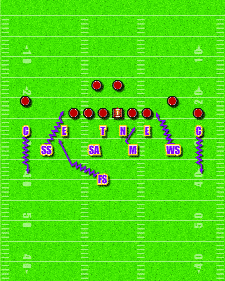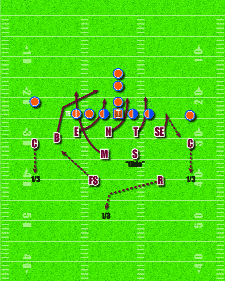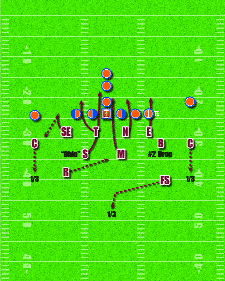AMERICAN FOOTBALL MONTHLY THE #1 RESOURCE FOR FOOTBALL COACHES
Article CategoriesAFM Magazine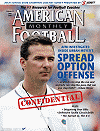
|
Hide and Seek: Disguising Your Blitzby: Dan Weil© More from this issue The blitz can be a potent weapon to nullify a high-flying air attack. But blitzes must be disguised to insure their effectiveness. If the offense knows they are coming ahead of time, it can easily adjust and burn the defense for major yardage. We talked to three successful coaches about how to disguise blitz packages: Mickey Matthews, head coach of former Division I-AA champion James Madison University in Harrisonburg, VA; Chuck Martin, head coach of defending Division II champion Grand Valley State University in Allendale, MI; and Tracy Claeys, defensive coordinator for Division I-AA stalwart Southern Illinois University. All three coaches believe that deception represents an essential element of any blitz. “When we blitz, we want the fake or the bluff to look exactly like the blitz itself in terms of hand and feet placement,” Matthews said. “We want the feet and arms to do the same thing. We coach it so hard, that I tell the players, ‘When we call a fake blitz, you should be so convincing to me that I thought you missed the call.’ “Most guys like to walk into their blitzes, then you tell them to fake, and they jump. We tell our guys that the teams we play pay their coaches good money, and their fake blitzes better look very similar to their active blitzes, or they aren’t going to fool anyone.” At Grand Valley State, Martin uses a 3-4 formation to disguise the blitz. “That gives you two inside linebackers and 2 outside,” he pointed out. “You can use a lot of combinations. We’ll also have the boundary safety [who is on the short side of the field] line up on the hash. With eight guys, you can disguise who’s coming and run a variety of coverage behind.” Martin likes to send his three down linemen and a combination of at least two other players from the back end of his defense on the blitz. “There are endless combinations, limited only by the imagination,” he said. “You can include the boundary corner also, so you can bring nine of 11 guys. You can mix and match how you bring them. Every week we try to design a new fire zone, with new people or the same people through different gaps. It’s almost like kids playing with a chalkboard.” On likely passing downs, Martin will utilize the same formation, whether his defense is blitzing or not. “We have a 3-4 look with two safeties and two corners,” he said. “We give a cover 2 look. It’s a guessing game for the offense. The quarterback has to figure it out after the ball is snapped. He has to figure out where we are coming from and the coverage.” Out of that 3-4 Grand Valley State sometimes utilizes three deep and three under with one man free. “One safety and two corners are deep, and a combination of a safety and other linebackers are underneath,” Martin said. “Another formation is two deep and four under. That would mean two safeties deep and two corners and two linebackers underneath.” The bottom line: “The offense doesn’t know who is coming on the blitz or who is ending up where in each coverage.” Claeys’ defense at Southern Illinois has two objectives in setting up its blitz formation. First, “Whatever zone coverage we’re running, we try to make the blitz package look exactly the same as if we’re not blitzing when the quarterback approaches the line of scrimmage,” he said. SIU employs a man coverage when it’s blitzing and a zone when it’s not. Second, “We try to find some kind of indicator of when the snap of the ball is coming, so we can disguise our blitz coverage and have players in proper position when the ball is snapped,” Claeys said. “The indicator might be the quarterback doing something with his hands in the shotgun, or it might be the center lifting his head up.” When SIU blitzes, it generally sends six defenders at the quarterback. “We’ll run a straight zero, man coverage,” Claeys said. “We don’t have a free safety in the middle of the field. So disguise is more important for us because we don’t have that free safety in the middle of the field to help us out. If you’re a man free team, disguise isn’t as important because you have help in the middle of the field.” For SIU, sometimes the free safety will blitz, and sometimes he will drop back into coverage. The six men blitzing for SIU will include the four linemen and a combination of any two players out of the remaining seven defenders. “It could be the linebackers, the safety or corners in the boundary, though not the field,” Claeys said. “Field” refers to the wide side of the field, as opposed to the “boundary”, or short side of the field. “Into the boundary, we play halves coverage – closer to the line of scrimmage than normal coverage,” Claeys said. “With the corners so close to the line of scrimmage, that’s a good disguise to bring a blitz from the corner.” SIU will blitz out of a 4-3 or 4-4 formation. “Any time there is a single receiver in the boundary, it’s an easy disguise to blitz the corner,” Claeys said. “If there are two or three receivers on a side, we have to show our hand early. The corners and safety have to move quickly to cover. With two or three receivers on the field side, it’s difficult to disguise a blitz, because it’s difficult for people to move over and cover them.” Matthews has his offensive coaches study his defense’s blitzes to see if there is something the team is giving away. “What we watch is when we’re faking the blitz, how does it affect the quarterback’s checks? “Is it even fazing the quarterback? The best thing is the element of surprise and forcing the quarterback to check off when we’re just faking a blitz. If we’re not affecting his checks, if he is not doing audibles, it’s obvious we’re giving something away and as a coach, you have to figure it out. You can give it away by where the safety lines up, by whether the corners have their inside or outside foot back. It could be the depth of the linebackers.” If the defenders are too close to the line of scrimmage, the offense will likely realize that a blitz is on. “There are so many ways you can give away your bluff that you really have to study it,” Matthews said. Grand Valley State probably has about 25 blitz combinations, Martin said. “We can bring both inside linebackers and have three or four different ways to do it – different places they are coming from based on the call. We can bring one inside linebacker and one outside linebacker. We can bring one inside linebacker and the boundary safety. We can bring the boundary corner and the outside linebacker. We can bring both outside linebackers.” And Martin will change the lanes that his players use to blitz. “There are four to five ways to bring just one inside linebacker and one outside linebacker. Mix that with the different ways you position your three down linemen, and the offense has to practice picking up all those different pressures. Our thing is that we have one look but can bring a lot of people. Opponents have to prepare for all these different possibilities. We may not run every one of them, but they still have to prepare for them.” For Matthews, the most important factor in deciding which of his players to bring on blitzes is how well they blitz, rather than which positions they play. “We like to blitz our good blitzers,” he said. “It could be a cornerback, a safety or a linebacker. You have to find the effective blitzers on your team. Some guys you could let blitz the entire game, and they wouldn’t make a sack. The way our blitz will run varies in accordance to who is the best blitzer.” The coaches have slightly different philosophies about what adjustments their linebackers should make on blitzes. Martin doesn’t really encourage adjustments for his linebackers. “When we’re blitzing, we don’t read out of it,” he said. “We just blitz and live with whatever call we have. Certainly there are disadvantages of not reading out of anything. There are certain times they’re running away from the blitz and you want to chase. But we have felt through the years that you make your blitzers more tentative by doing that. This way, our guys go as hard as possible and chase if they have to. We try to make our guys aggressive and not thinking too much when they make their blitz.” For Claeys, it’s important that his linebackers keep their eyes on the offensive linemen as they go through their blitz. “We make sure our linebackers see where the offensive linemen are going. I don’t want them running right in the center of a 300-pounder. They have to keep their eyes on the linemen so they can adjust and run to the gaps.” Matthews said the adjustments his linebackers make depend on where they are coming from in the blitz. One of his linebackers will have “flare control” responsibility. “If you’re blitzing and the running back runs a flare instead of blocking, we call that a blitz peel,” he said. “Sometimes the linebacker will do the blitz anyway, and sometimes he covers the running back instead. If it’s a blitz peel, the linebacker will peel off to cover the running back. The linebacker is reading whether the running back is running a flare or blocking.” The coaches also have slightly different methods for dealing with audibles. Martin doesn’t call off a blitz when the quarterback audibles. “Once we have a blitz, we roll with it,” he said. “If you do a good job of disguise, they may do the wrong audible. The offense isn’t necessarily going into the right play all the time. Sometimes they think we’re coming and we aren’t. And sometimes they think we aren’t coming, and we are. We give one look and say deal with it.” At SIU, the defense has an alert call to cancel blitzes. “If the quarterback changes the play, we’ll drop out of our man blitz, and go to a zone. That’s the linebacker’s call. We don’t always use the alert call. In certain situations, we’ll run the blitz regardless. But if we’re worried about the offense checking out, we’ll call an alert and get out of the blitz.” And the new coverage would be dictated by the offense’s tendencies, Claeys said. “A common check when you’re blitzing is for the offense to audible to run receivers on hitch or slant routes. So our alert call would be to take those slants or hitches away by covering receivers instead of blitzing.” Matthews’ blitz strategy with audibles varies. “With some defenses, you’ll stay with the blitz, with others you won’t,” he said. “You make the call in the huddle.” Overall, there are two keys to blitz disguise, Martin said. “The main thing is you want to give one look and, secondly, keep it simple for the kids,” he said.
JMU and SIU’s X’s & O’s blitz packages above can also be seen in simulated animation below: 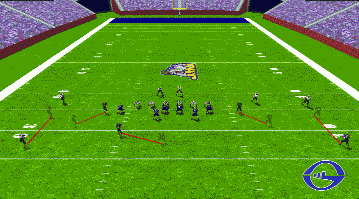 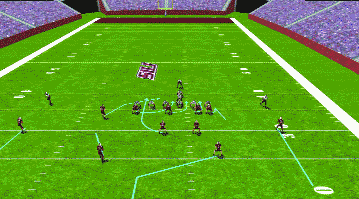 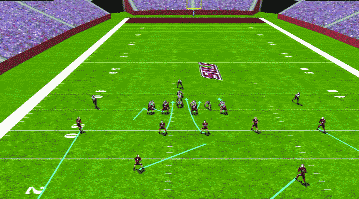 |
|
| HOME |
MAGAZINE |
SUBSCRIBE | ONLINE COLUMNISTS | COACHING VIDEOS |
Copyright 2026, AmericanFootballMonthly.com
All Rights Reserved


